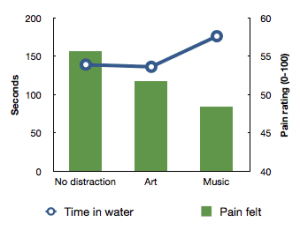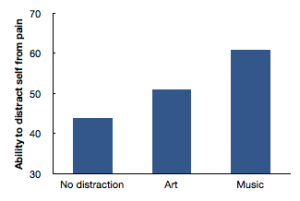Thank you today to Father Seraphim Holland of St. Nicholas Russian Orthodox Church, one of my blog readers, who sent me a link to this interesting study by authors Laura A. Mitchell, Raymond A. MacDonald, and Christina Knussen in my email just today:
The authors examined the effects of preferred music, visual distraction, and silence on pain perception. Visual distraction was provided by participants’ choice of painting from a selection of 15 popular artworks. Eighty participants (43 females) underwent 3 trials of cold pressor pain induction with measurement of tolerance, pain intensity, perceived control, and anxiety, and a music listening patterns questionnaire. Preferred music was found to significantly increase tolerance and perceived control over the painful stimulus and to decrease anxiety compared with both the visual distraction and silence conditions. Pain intensity rating was decreased by music listening when compared with silence. During the music condition, frequent listening to the chosen piece in everyday life was found to negatively correlate with anxiety level, and extent of knowledge of the lyrics further positively correlated with tolerance of the stimulus and perceived control. That general importance of music in everyday life also correlated with perceived control reiterates the importance of relationship and familiarity with favorite music as key to its therapeutic effect. [emphasis added] There was no relationship between structural features of the selected music and any of the significant effects. It is suggested that preference may render music with different structural aspects functionally equivalent.
Here we see that self-selected music is better than silence or self-selected artwork at distracting people from pain. This does not mean that the art had no effect; in fact the figures below are even more telling:
Not only did the artwork enable people to distract themselves better, but they felt less pain, as well. Now, the authors here allowed people to select their own music, and state that the kind of music was irrelevant to the study. That may be true. However, let us not forget that classical music has other benefits and the study authors did not address the type of music. This study is not the only study to address music and tolerance to pain, so this study is confirmation of what we already know.
My advice, from personal experience: next time you go into the dentist’s office, fill up your mp3 player with songs from the classical repertoire, in whatever language you find the words understandable. If your player is more advanced and has the ability to display videos, it might be worthwhile to load your favorite artwork on it, too! Doing this may just make the whole process a little easier to take!

